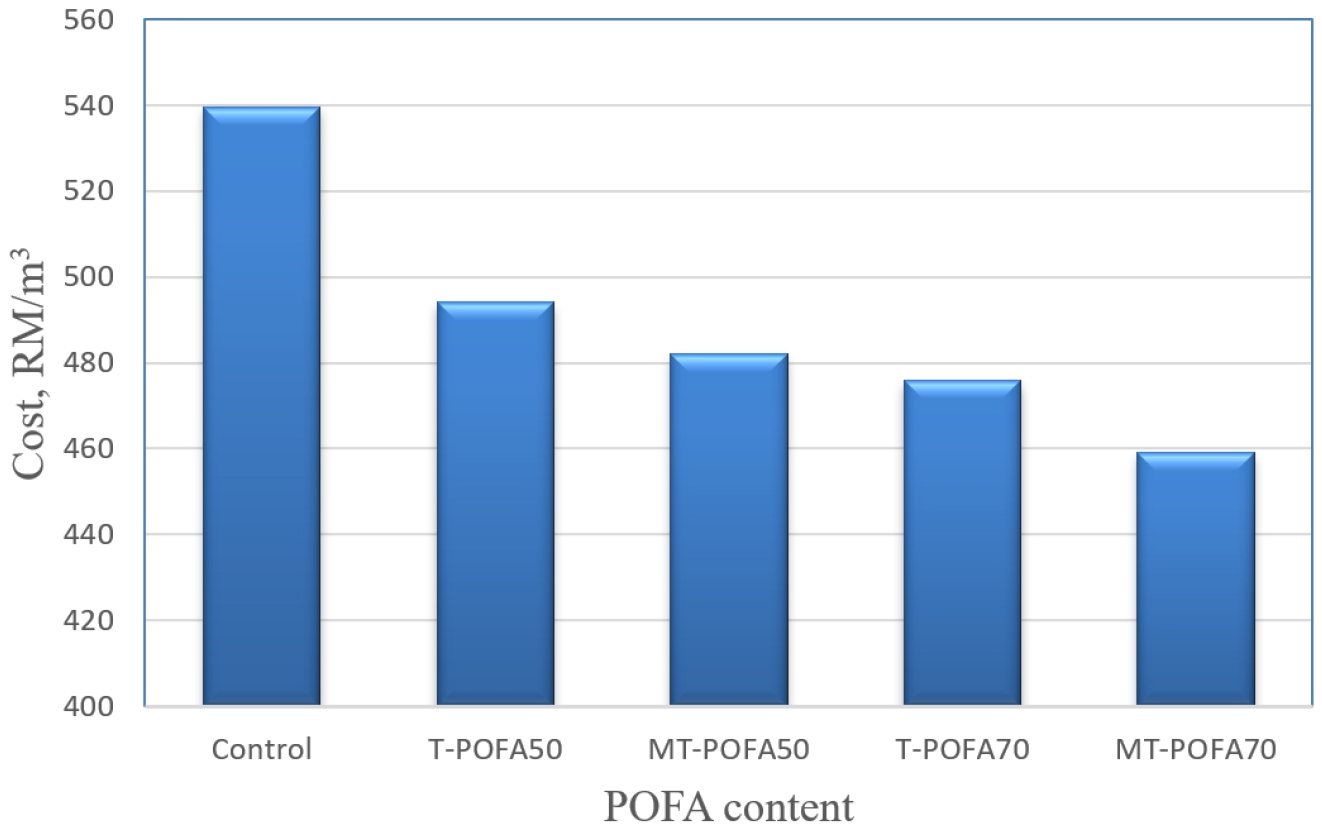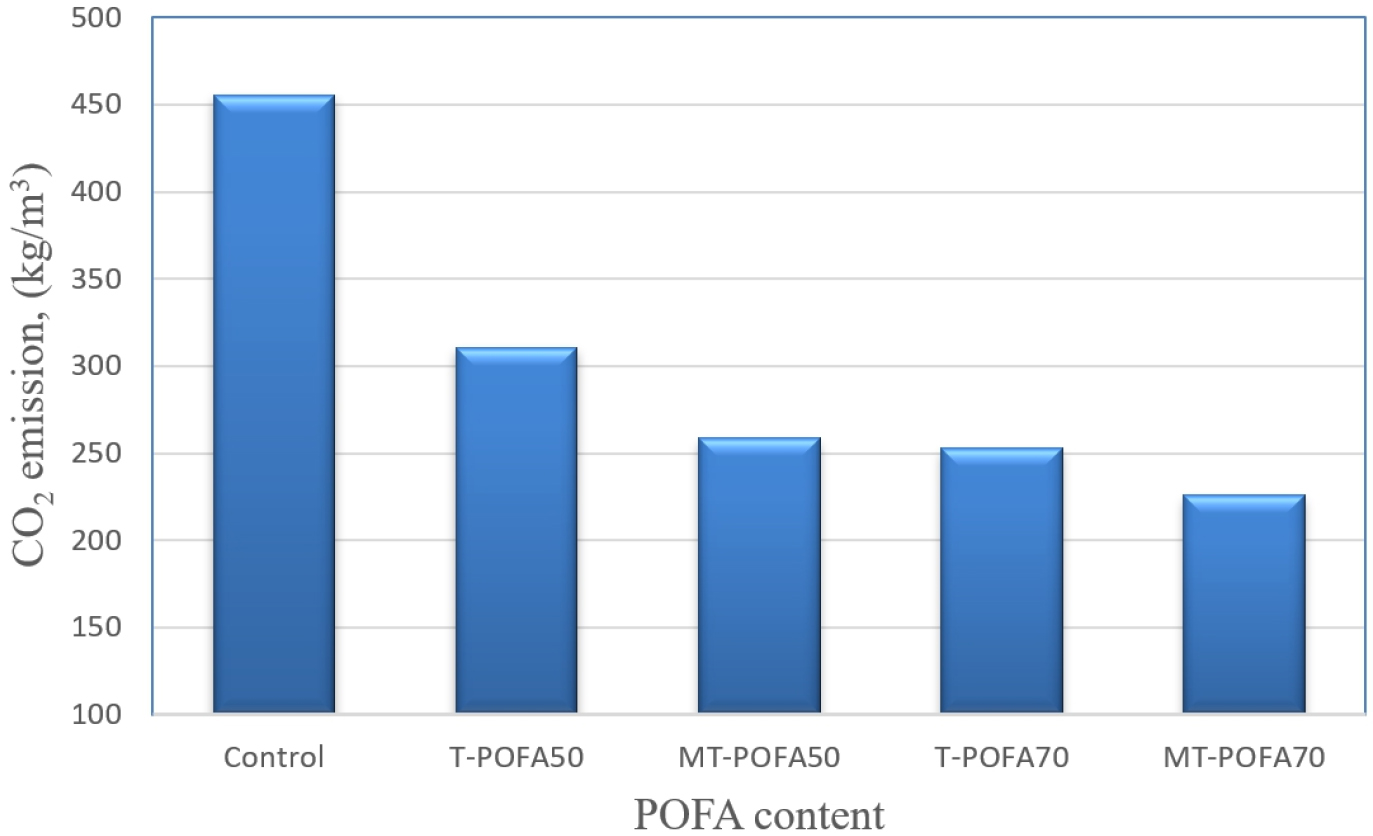Introduction
Materials and Testing Methods
Mix Proportions, Fresh Properties, and Strength of SCC
Cost and CO2 Analysis of SCC Containing T-POFA and MT-POFA
Results and Discussion
Properties of SCC
Cost of SCC
Sustainability of the SCC
Applications of SCC
Conclusion
Introduction
Self-compacting concrete (SCC) is a type of concrete with low flow resistance that may be cast and compacted by its own weight without the need for external vibration, bleeding, or segregation during the casting process [1, 2]. SCC saves costs by decreasing construction time, equipment, and expert personnel needs due to its ease of placement. Also, it improves the working environment by reducing vibration and noise throughout the production processes [3, 4]. Moreover, increasing the flowability of SCC can improve the aesthetic and durability of the final product [5, 6]. However, making SCC necessitates the use of some special superplasticizers and viscosity modifying admixtures, which are costly. SCC comprises less aggregate and has a higher binder volume than normal vibrated concrete [2, 7], which leads to a higher construction cost.
Reduced OPC volume in SCCs employing supplementary cementitious materials (SCMs) as a partial replacement for OPC is one solution to the concerns stated above [8]. Incorporating SCMs in SCC improve concrete workability, improve concrete properties, boost job site productivity, and lower costs. [9, 10]. Therefore, this research aims to treat palm oil fuel ash in two different treatment methods and use it in high quantities to make low-cost SCC with minimal environmental impact. The cost and sustainability of SCCs containing treated POFA (T-POFA and MT-POFA were evaluated.
Materials and Testing Methods
Mix Proportions, Fresh Properties, and Strength of SCC
In published articles [11, 12], the methods of preparation for treated POFA, mix proportions, fresh properties, and compressive strength were described and intensely discussed as this is a part of a continuous project.
Cost and CO2 Analysis of SCC Containing T-POFA and MT-POFA
One of the most significant aspects to consider during the production of concrete is the cost. Price comparison was done using market prices for materials sourced from various sources to produce SCC. The analysis and the calculation of the costs are the average values obtained for the year (2017) to ensure consistency in the cost evaluation. The final cost of T-POFA and MT-POFA has been obtained from the cost of raw materials and the price of using electricity during the preparation processes. The processes for T-POFA were drying, grinding, and heating, while for MT-POFA were heating and grinding. At the current state, raw POFA is available without any cost involved. The cost of the electricity used was obtained based on the total kW which was measured during the grinding and heating processes.
For the carbon dioxide emissions (CO2) calculation, in this study, the system boundary approach is used to assess the environmental impact of concrete materials extraction, transportation, and treatment. The calculation processes were explained in detail in a previous related study and its summary is mentioned in Table 1[11].
Results and Discussion
Properties of SCC
The fresh properties and compressive strength of SCC incorporating T-POFA and MT-POFA were examined and evaluated. The results of these properties were presented and explained in previously published articles [11, 12].
Cost of SCC
The use of cheaper SCMs to replace OPC not only improves the concrete properties but can also reduce the cost of the concrete. As explained in Table 1, the cost of OPC is 8, 6, 1.76, and 2.2 times higher than those of coarse aggregate, sand, T-POFA, and MT-POFA, respectively. Therefore, OPC is the highest material that causes the concrete’s cost. As shown in Figure 1. The reductions in the cost of the SCC including 50% and 70% T-POFA are 8%, and 11%, whereas for SCC with 50% and 70% MT-POFA, they are 10% and 14%, respectively. It should be noted that the labor cost was not included in this calculation. The use of high volumes T-POFA and MT-POFA reasonably decreased the cost of SCC. Aside from making cheaper SCC, using this waste as OPC substitute enhances mechanical characteristics and durability while reducing the negative environmental effects. This results are in good agreement with studies utilized supplementary cementitious materials (SCMs) such as fly ash (FA) and rice hush ash (RHA) [13, 14, 15]. These studies found that incorporating SCMs in concrete led in cost saving.
Table 1
A summary of the price and CO2 emissions for the major constituents of SCC
| Item | Unit | Price (RM)/ unit | Carbon dioxide emissions | |
| CO2/unit | References | |||
| electricity. | kWh | 0.218 | 0.25 | [16] |
| Distance (medium car) | Km | - | 0.18 | [16] |
| OPC | Kg | 0.44 | 0.91 | [17] |
| Aggregate | Kg | 0.055 | 0.0459 | [18] |
| Sand | Kg | 0.08 | 0.0139 | [18] |
| Superplasticizer | Kg | 38 | 0.01 | [19] |
| T-POFA | Kg | 0.25 | 0.32 | [11] |
| MT-POFA | Kg | 0.20 | 0.24 | Based on this study |
It is worth noting that even though the initial cost of SCC ingredients is high due to the use of high cement content and expensive SP compared with ordinary concrete, the overall cost of SCC is considered to be reasonable. This occurrence can be attributed to the savings that can be attained due to the minimal labor involved, reduced concrete quantity due to the reduced cross-section of structural elements, improved productivity, and low maintenance due to improvements in the quality and durability of concrete. The improved durability of SCC extends the service life of concrete structures and decreases their maintenance cost.
Sustainability of the SCC
The replacement of cement, especially in high volume, with waste materials such as T-POFA and MT-POFA can be very beneficial to the environment and can lead to reducing the amount of dumped waste and producing green concrete. In 2011, around 2.3 gigatons of CO2 were emitted worldwide due to the manufacturing of approximately 3.3 gigatons of cement [17]. As a result, replacing wastes for OPC, which is made from non-renewable raw resources, results in the creation of sustainable and environmentally friendly concrete while lowering CO2 emissions.
The relationship between estimated CO2 and OPC substitution levels is shown in Figure 2. When T-POFA and MT-POFA are utilized to substitute OPC, CO2 emissions are significantly reduced. With reducing the quantity of OPC and the increasing replacement levels of treated POFA, the CO2 from SCC incorporating 50% and 70% T-POFA can be as low as 32% and 45%, while for SCC containing 50% and 70% MT-POFA, it is 42% and 51%, respectively, compared with the control SCC made with OPC only. This reduction in CO2 is due to high OPC substitutions, which are the major source of CO2 in the production of concrete. The development of binary blended types of cement at a high level of replacement has resulted in significant CO2 savings because Portland cement is replaced with low-carbon SCMs.
MT-POFA produced about 24% lesser CO2 emissions than T-POFA, which can lead to the production of environmentally friendly concrete as well as greenhouse gas emissions reduction. This reduction is because the drying and sieving processes were eliminated for MT-POFA, hence leading to lower energy consumption [12]. Both types of treated POFA exhibited lower CO2 emissions compared to cement.
Besides using locally available waste material to produce sustainable and eco-friendly SCC, other factors can make SCC more sustainable. For example, the good fresh properties of SCC (filling ability, passing ability, and segregation resistance) can lead to easier pumping of the fresh concrete, eliminating the vibration process and reducing the level of noise. All of these effects reduce energy consumption in the construction processes, thus leading to high energy efficiency. Moreover, the good mechanical properties and durability can cause SCC to serve and sustain in severe environmental conditions. Therefore, the enhanced durability of SCC prolongs the service life of the concrete structure and reduces the possibility of maintenance or demolishing of the structure.
Applications of SCC
SCC has been applied to different structural and architectural concrete elements where components are congested, reinforced and surface smoothness is important. The major implementations of SCC include buildings, bridges, tunnels, etc. It has been employed in both precast and cast-in-situ construction. Some practical applications of SCC are presented in Table 2.
Table 2
Some practical applications of SCC
| Structure | Location | Reference |
| The Cathedral of Christ the Light, Oakland, California. SCC was used to cast the curving concrete reliquary walls, which serve as both structural and exposed architectural surfaces. SCC was selected for many reasons, with heavy reinforcement in the walls, the requirement for sharp details, and identical aesthetics on the uncovered walls. | USA | [20] |
| The Jin Mao Building, Shanghai, used SCC to construct a 4 m thick, 64 x 64 m foundation in 1997. | China | [21] |
| The Ritto Bridge was constructed using precast SCC piers. The highest pier was 65 m high. The compressive strength was 50 MPa and the slump flow was 600−650 mm. | Japan | [2] |
| Anchorages of the Akashi-Kaikyo suspension bridge. The SCC was mixed on the job site in a batch plant and pumped 200 meters distant to the anchorages via a piping system. | Japan | [2] |
| SCC was primarily used by the Trump Tower in Chicago. To build the mat foundation that supports the finished structure, SCC is cast-in-place continuously for 22 hours. The mix had a seven-day compressive strength of 68 MPa and a 28-day strength of 82 MPa. This single pour is the largest ever recorded in North America using SCC. | USA | [21] |
| The Kesar Solitaire is a commercial complex located in Mumbai. The water-table is around 1 m below the ground level of this commercial complex, which is located near a creek. The water was discovered to be quite saline, with a high chloride level. Another concern on the job site was the impending monsoons; the basement had to be finished before the monsoons began, otherwise the site would have been flooded. It was therefore agreed to use SCC grade 40 for the triple structure of the basement, which was located about 10 m under the ground level. | India | [22] |
| The Burj Dubai (the Tower of Dubai) is now the tallest building in the world. SCC was used throughout the structure, except for the floor. The compressive strength of the structural elements ranged from 62 to 80 MPa. The slump flow was 610 to 710 mm. | UAE | [21] |
| SCC was used to cast the new concrete flooring for subsurface settling tanks that were being repaired in the City of Cleveland Municipal Waste Water Treatment Plant. The concrete was poured several hundred meters above ground into the subsurface tanks via pumping pipes. The SCC featured a 500–600 mm slump flow and a strong troweled surface finish. The SCC possessed a 500–600 mm flowability and a strong troweled surface finish. | USA | [17] |
| Self-compacting concrete was utilized For the construction of the concrete foundation of the reservoir, it was used about 70 concrete mixer trucks, each with about 8 m³, totaling 620 m³ of SCC. | Brazial | [23] |
Conclusion
In this research, 50–70% of OPC was replaced with T-POFA or MT-POFA by weight in SCC. It is concluded that the total cost of producing SCC containing 50% T-POFA was decreased about 8% and SCC containing 50% MT-POFA was reduced by approximately 11%, while the reduction of CO2 emissions was approximately 32% for SCC with 50% T-POFA and 41% for SCC with 50% MT-POFA in comparison to SCC made with OPC only.






